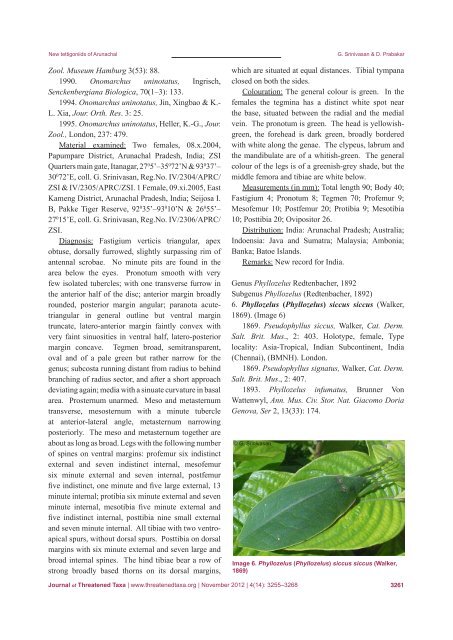View - Journal of Threatened Taxa
View - Journal of Threatened Taxa
View - Journal of Threatened Taxa
You also want an ePaper? Increase the reach of your titles
YUMPU automatically turns print PDFs into web optimized ePapers that Google loves.
New tettigoniids <strong>of</strong> ArunachalZool. Museum Hamburg 3(53): 88.1990. Onomarchus uninotatus, Ingrisch,Senckenbergiana Biologica, 70(1–3): 133.1994. Onomarchus uninotatus, Jin, Xingbao & K.-L. Xia, Jour. Orth. Res. 3: 25.1995. Onomarchus uninotatus, Heller, K.-G., Jour.Zool., London, 237: 479.Material examined: Two females, 08.x.2004,Papumpare District, Arunachal Pradesh, India; ZSIQuarters main gate, Itanagar, 27 0 5’–35 0 72’N & 93 0 37’–30 0 72’E, coll. G. Srinivasan, Reg.No. IV/2304/APRC/ZSI & IV/2305/APRC/ZSI. 1 Female, 09.xi.2005, EastKameng District, Arunachal Pradesh, India; Seijosa I.B, Pakke Tiger Reserve, 92 0 35’–93 0 10’N & 26 0 55’–27 0 15’E, coll. G. Srinivasan, Reg.No. IV/2306/APRC/ZSI.Diagnosis: Fastigium verticis triangular, apexobtuse, dorsally furrowed, slightly surpassing rim <strong>of</strong>antennal scrobae. No minute pits are found in thearea below the eyes. Pronotum smooth with veryfew isolated tubercles; with one transverse furrow inthe anterior half <strong>of</strong> the disc; anterior margin broadlyrounded, posterior margin angular; paranota acutetriangularin general outline but ventral margintruncate, latero-anterior margin faintly convex withvery faint sinuosities in ventral half, latero-posteriormargin concave. Tegmen broad, semitransparent,oval and <strong>of</strong> a pale green but rather narrow for thegenus; subcosta running distant from radius to behindbranching <strong>of</strong> radius sector, and after a short approachdeviating again; media with a sinuate curvature in basalarea. Prosternum unarmed. Meso and metasternumtransverse, mesosternum with a minute tubercleat anterior-lateral angle, metasternum narrowingposteriorly. The meso and metasternum together areabout as long as broad. Legs with the following number<strong>of</strong> spines on ventral margins: pr<strong>of</strong>emur six indistinctexternal and seven indistinct internal, mes<strong>of</strong>emursix minute external and seven internal, postfemurfive indistinct, one minute and five large external, 13minute internal; protibia six minute external and sevenminute internal, mesotibia five minute external andfive indistinct internal, posttibia nine small externaland seven minute internal. All tibiae with two ventroapicalspurs, without dorsal spurs. Posttibia on dorsalmargins with six minute external and seven large andbroad internal spines. The hind tibiae bear a row <strong>of</strong>strong broadly based thorns on its dorsal margins,G. Srinivasan & D. Prabakarwhich are situated at equal distances. Tibial tympanaclosed on both the sides.Colouration: The general colour is green. In thefemales the tegmina has a distinct white spot nearthe base, situated between the radial and the medialvein. The pronotum is green. The head is yellowishgreen,the forehead is dark green, broadly borderedwith white along the genae. The clypeus, labrum andthe mandibulate are <strong>of</strong> a whitish-green. The generalcolour <strong>of</strong> the legs is <strong>of</strong> a greenish-grey shade, but themiddle femora and tibiae are white below.Measurements (in mm): Total length 90; Body 40;Fastigium 4; Pronotum 8; Tegmen 70; Pr<strong>of</strong>emur 9;Mes<strong>of</strong>emur 10; Postfemur 20; Protibia 9; Mesotibia10; Posttibia 20; Ovipositor 26.Distribution: India: Arunachal Pradesh; Australia;Indoensia: Java and Sumatra; Malaysia; Ambonia;Banka; Batoe Islands.Remarks: New record for India.Genus Phyllozelus Redtenbacher, 1892Subgenus Phyllozelus (Redtenbacher, 1892)6. Phyllozelus (Phyllozelus) siccus siccus (Walker,1869). (Image 6)1869. Pseudophyllus siccus, Walker, Cat. Derm.Salt. Brit. Mus., 2: 403. Holotype, female, Typelocality: Asia-Tropical, Indian Subcontinent, India(Chennai), (BMNH). London.1869. Pseudophyllus signatus, Walker, Cat. Derm.Salt. Brit. Mus., 2: 407.1893. Phyllozelus infumatus, Brunner VonWattenwyl, Ann. Mus. Civ. Stor. Nat. Giacomo DoriaGenova, Ser 2, 13(33): 174.© G. SrinivasanImage 6. Phyllozelus (Phyllozelus) siccus siccus (Walker,1869)<strong>Journal</strong> <strong>of</strong> <strong>Threatened</strong> <strong>Taxa</strong> | www.threatenedtaxa.org | November 2012 | 4(14): 3255–32683261

















